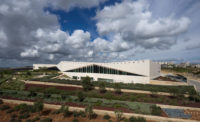Aga Khan Award Winners for 2007 Named

Aga Khan Award Winners 2007
Photo by Foster + Partners, Courtesy the Aga Khan Award for Architecture

Aga Khan Award Winners 2007
Photo by Dimitri Vattis, Courtesy the Aga Khan Award for Architecture

Aga Khan Award Winners 2007
Photo by Geraldine Bruneel, Courtesy the Aga Khan Award for Architecture

Aga Khan Award Winners 2007
Photo by Anne De Henning, Courtesy the Aga Khan Award for Architecture

Aga Khan Award Winners 2007
Photo by Amir-Massoud Anoushfar, Courtesy the Aga Khan Award for Architecture

Aga Khan Award Winners 2007
Photo by Anne De Henning, Courtesy the Aga Khan Award for Architecture

Aga Khan Award Winners 2007
Photo by Tim Griffith, Courtesy the Aga Khan Award for Architecture

Aga Khan Award Winners 2007
Photo by Christian Richters, Courtesy the Aga Khan Award for Architecture

Aga Khan Award Winners 2007
Photo by Birol K.S. Inan, Courtesy the Aga Khan Award for Architecture









|










